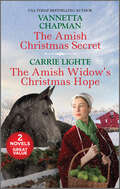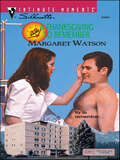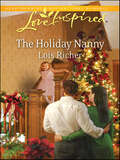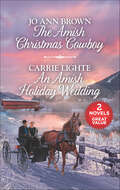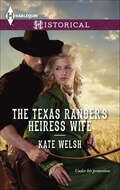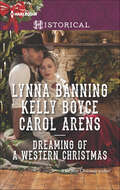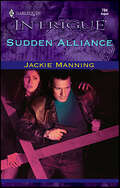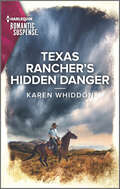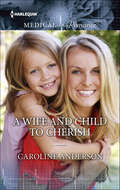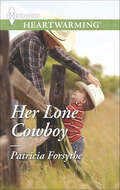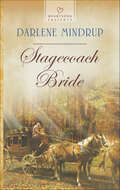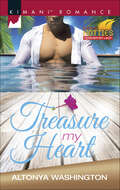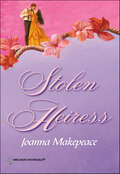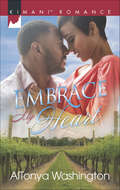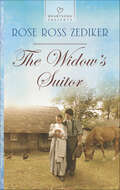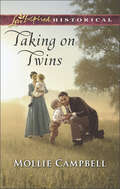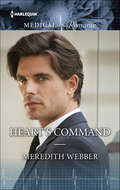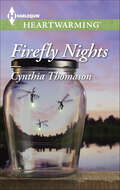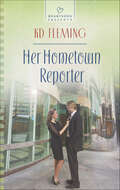- Table View
- List View
The Amish Christmas Secret and The Amish Widow's Christmas Hope
by Vannetta Chapman Carrie LighteCan true love find a way?The Amish Christmas Secret by Vannetta ChapmanBecca Schwartz&’s curiosity is going to be a problem. When Amish secret millionaire Daniel Glick moves to Shipshewana for seclusion, he doesn&’t expect his pretty new neighbor to ask so many questions. Or to be so generous, despite her family&’s poverty. As Daniel falls for Becca, his secret looms between them. This Christmas, can he finally give her the truth…and his heart?The Amish Widow&’s Christmas Hope by Carrie LighteAfter inheriting her uncle&’s house, single mother Fern Glick returns to Serenity Ridge with the intention to sell and leave town quickly. But her reluctance to settle so close to former love Walker Huyard—the man who broke her heart—begins to falter as their children forge a bond. With Christmas approaching, spending the holiday together might just be enough to reignite the love they once shared.USA TODAY Bestselling Author Vannetta Chapman
A Thanksgiving to Remember (36 Hours)
by Margaret WatsonA KILLER IS ON THE LOOSE...A MAN WITH NO MEMORY STANDS ACCUSED...ONE NURSE PUTS HER LIFE ON THE LINE...No one knew who “Tom Flynt” was. But Tina White, the nurse tending to the amnesiac patient, was certain of one thing. His warm brown eyes could not be those of a cold-blooded killer-or could they? Under that gruff yet impressively muscular exterior lurked a gentle man. And with the tender kisses and seductive caresses Tom began sharing with her, Tina sensed she was in danger of losing her heart. Could discovering his true identity imperil her life, as well...?
The Holiday Nanny
by Lois RicherWorkaholic single father Wade Abbot is away on business, as usual, when he receives a heart-tugging video from his four-year-old. The little girl hopes he'll come home for Christmas-and see her in the holiday pageant. With his harrowing past, Wade has always doubted his ability to be a good father, but he heads home to Arizona, determined to try. His daughter's loving new nanny, Connie Ladden, works overtime to help turn him into the father he longs to be. And with some help from his little girl, Wade just might turn his holiday nanny into a permanent wife and mother.
Their Amish Agreement
by Patricia Davids Patrice LewisFrom "for now" to…forever?Shelter from the Storm by Patricia Davids Secretly pregnant and unwed, Gemma Lapp has a difficult choice—face her Amish community or raise her baby alone. But when a storm strands Gemma in the wilderness with her former crush, Jesse Crump, she knows her secret won&’t be safe for long. Gemma can&’t imagine trusting a man again…until Jesse proposes a marriage of convenience. Could their arrangement lead to love?Amish Baby Lessons by Patrice Lewis Tall, plain and awkward, Amish maed Jane Troyer has always been &“useful.&” Now she&’s the temporary nanny for overwhelmed Amish bachelor Levy Struder and his baby niece. But Jane&’s finding it hard to resist falling for the sweet boppli and handsome, hardworking Levy. Can this spirited plain Jane win a bachelor&’s heart…and make their temporary arrangement permanent?USA TODAY Bestselling Author Patricia Davids Previously published as Shelter from the Storm and Amish Baby Lessons
The Amish Christmas Cowboy and An Amish Holiday Wedding
by Jo Ann Brown Carrie LighteChristmas Heals Hearts in Amish CountryThe Amish Christmas Cowboy by Jo Ann BrownNanny Sarah Kuhns has her hands full with kinder, her overbearing brothers and her big dreams. And it only gets worse when she takes on the care of an injured cowboy. For Amish traveling horseman Toby Christner, tight-knit Harmony Creek represents everything he’s run from. Until he heals, he can’t leave…but will falling for Sarah make him want to stay?An Amish Holiday Wedding by Carrie LighteOn the brink of losing her bakery, the last thing Faith Yoder is interested in is courting—until Hunter Schwartz returns to Willow Creek. After hiring him to deliver her treats to a Christmas festival, Faith is determined their relationship will stay strictly professional. But despite a secret that’s kept her single, Faith can’t help but wish she and Hunter could become husband and wife.
The Texas Ranger's Heiress Wife
by Kate WelshWORLDS APART... Pampered society princess Helena Conwell has built a successful ranch from a ruined wreck, but now hostile raiders are hungry for her land. Only one man can protect her-Brendan Kane, the wild Texas Ranger she married at gunpoint. After three years away, Brendan vows to defend the ranch and claim his wife back. Irish-born and darkly irresistible, he still has the power to quicken Helena's heart with his emerald-green gaze. But, each as fiercely proud as the other, can they admit to still being in love?
Dreaming of a Western Christmas
by Lynna Banning Kelly Boyce Carol ArensThree festive stories to make your dreams come true HIS CHRISTMAS BELLE by Lynna Banning Nursemaid to a spoiled Southern belle isn't how loner Brand Wyler imagined spending Christmas. But beautiful Suzannah's intrepid spirit makes him feel less empty inside... THE COWBOY OF CHRISTMAS PAST by Kelly Boyce Ada had left her dreams of cowboy Levi MacAllistair behind. Until one Christmas he arrives injured on her doorstep! Maybe it's time for Ada to reveal the truth about their son... SNOWBOUND WITH THE COWBOY by Carol Arens Mary Blair's Christmas wishes come true when Joe Landon seeks shelter from the snow. The handsome cowboy wants to adopt the orphans in her care. The catch: he needs a wife!
Her Amish Christmas Gift and Her Amish Holiday Suitor: A 2-in-1 Collection
by Rebecca Kertz Carrie LighteA surprising Amish Christmas!Her Amish Christmas Giftby Rebecca KertzAfter his brother is injured while their family’s away, Nathaniel Peachy needs help on the farm—even if the only option is young, carefree Charlotte Stoltzfus. No longer the irresponsible girl Nate remembers, Charlie wishes he could see her as a woman worthy of love. Because with the holidays approaching, she’s starting to believe Nate might just be her perfect holiday gift.Her Amish Holiday Suitor by Carrie LighteLucy Knepp has no time for heartbreaker Nick Burkholder…until a pretend courtship means she can finish her embroidery for a Christmas fund-raiser in peace. Nick’s arrangement with too-reserved Lucy is the perfect cover while he repairs the cabin his brother damaged. But once Nick sees how vibrant Lucy really is, can he prove himself—and show their love is for all seasons?
Sudden Alliance
by Jackie ManningA MAN LIKE NO OTHER...When Liam O’Shea found a young beauty on the side of the road, battered and incoherent, his razor-sharp instincts-honed by years of training as an undercover operative-warned she was in trouble. Honor demanded he offer his protection.WITH AN IMPOSSIBLE MISSION!The only witness to an unspeakable murder she couldn’t remember, Sara Regis was in danger-with her only hope for survival in Liam’s strong arms. Now, as Liam and Sara joined forces to locate a killer, would their sudden alliance withstand the secrets she’d kept locked inside?
A Love So Strong
by Arlene JamesIn need of a wife, Pastor Marcus Wheeler was sure God would send him a good woman—anyone except Nicole Archer. Though she was kind and beautiful, she was far too young and unconventional to be a proper minister's wife. She couldn't possibly be the one for him. But the more time he spent with Nicole, the more he marveled at her strength and spirit. Nicole made juggling school and family responsibilities seem easy, yet Marcus knew he could help ease her burdens—and make her smile. Sometimes God's plan isn't what one expects....
Texas Rancher's Hidden Danger
by Karen WhiddonHelp Wanted: A housekeeper with a hidden past… Single dad Ted Sanders thinks he&’s hit the jackpot when he hires Amelia Ferguson as a housekeeper for his ranch in Getaway. But even as she becomes a loving confidante for his teenage girls, Amelia&’s hiding a terrible secret: she&’s fled—complete with a new identity—from the fearsome Coffee Shop Killer. As undeniable electricity sparks between her and Ted, can he keep Amelia safe from a murderer?From Harlequin Romantic Suspense: Danger. Passion. Drama.
A Wife and Child to Cherish
by Caroline AndersonA bride for a surgeonWhen the Audley's new consultant, Patrick Corrigan, meets nurse and single-mom Annie Mortimer, he is captivated by her kindness, her courage and her fierce independence. Annie and her daughter bring out all of Patrick's protective instincts. In helping them, Patrick finds a desire and a purpose that he thought he'd never feel again. Patrick is sure that the three of them can be the perfect family. But first he must find a way to convince Annie that his support is unconditional and that his home and his heart are open for her and her little girl.
His Lady Fair
by Margo MaguireHow Could He Love This Daughter Of Treason...?Yet with his heart so full, his passion so afire, how could he not? Nicholas Hawken had never found a woman so attuned to his touch, his taste, his very being, as Lady Maria Burton. Though if her father proved traitorous, he was duty bound to expose him...and so destroy their love!From household drudge to daughter of a duke, Maria Burton had been forever transformed. But nothing had been as soul-shattering as what she'd experienced with Nicholas Hawken, infamous scoundrel, intriguing rogue...and truebound mate-of-her-heart!
Her Lone Cowboy
by Patricia ForsytheA new book from USA TODAY bestselling author Patricia Forsythe...He was looking for a quiet place to heal From the hair-raising moment he rescues his neighbor's young son from an overprotective wild mare, wounded vet Caleb Ransom knows he'll have no peace. Living an isolated existence on his Arizona cattle ranch is out of the question with the intrusive Delaney Reynolds around. And once the single mother's little boy starts bonding with Caleb's mutt, it may be time to surrender... Because she's making Caleb yearn for something he didn't even know he wanted.
Stagecoach Bride
by Darlene MindrupStagecoach Driver Adam Clark Is Used to Surprises But he never thought he'd find his childhood friend Amanda Ross applying for a dangerous driver's job. Now Adam's "little bundle of dynamite" is all grown up...and sparking feelings that are anything but brotherly. If he can't talk her out of her crazy scheme to assert her independence, he'll just have to protect her. Amanda's fiery personality dwarfs her small stature, but their journey westward tests even her indomitable spirit. And she learns she can trust Adam to keep her safe in the swirl of danger that surrounds them. Can these two old friends survive a treacherous trip...and open their hearts to one another before it's too late?
Treasure My Heart
by AlTonya WashingtonThe man every woman wants...wants her There are flings, and then there's real life. Minka Gerald, assistant to one of the country's top financiers, is too smart to confuse the two. But a business trip to Miami is the perfect place for a workaholic to let loose, and Oliver-brother to her boss's fiancée-is the ideal partner-in-pleasure. And with his heartbreaker reputation, that's as much as she expects. A ladies' man doesn't become a one-woman guy overnight. But once property developer Oliver Bauer has a taste of real connection, he wants more. Outwardly reserved but full of fire, Minka could hold his heart forever. Can he make her believe in him, before an old enemy's quest for revenge puts her safety and their sizzling new love in jeopardy?
Stolen Heiress
by Joanna MakepeaceRevenge and...marriage?Clare Hoyland had witnessed the most vicious behavior between her family and those dreadful Devanes. But when her brother killed all but one member of the Devane family, Clare knew she was next to suffer. For as she set out on a journey, the sole survivor, Robert Devane, carried her off into the dark wilderness. Her handsome captor meant to avenge his family's slaughter by marrying her! Though his wife and prisoner, Clare couldn't help falling in love with her own husband. Would they never give up this bitter family feud and admit those tender feelings that had stirred from the moment they touched?
Embrace My Heart
by AlTonya WashingtonIs she ready to trust again? All of the delights and none of the drama-that's what heiress and gallery owner Vectra Bauer wants from her fling with Qasim Wilder. The gorgeous financial adviser has been Vectra's platonic friend, but now, after the end of her last painful relationship, she's ready to take a small risk and open her heart. Settling for a little of anything isn't Sim's ideal. Possessive by nature, he makes no secret of how much he wants Vectra. And he can't understand why she's hiding from their intense connection that's way more than just physical. The man who always gets what he wants is embracing his biggest challenge yet: to make the woman he adores believe in love once more...
The Widow's Suitor
by Rose Ross ZedikerCORA ANDERSON ISN'T LOOKING FOR LOVE The young widow is just trying to make a life on the prairie for herself and her newborn son. When handsome newcomer Luke Dow shows up at her cabin door, she soon relies on the man's help with her homestead...and dares to dream of the future. Luke came to the small South Dakota town to build a hotel and make his fortune. But he never expected to care for anyone, let alone the beautiful Cora and her baby boy. When Cora's land claim is challenged by a neighbor, Luke will do all he can to protect her and her home-and claim her heart.
Undercover Nanny
by Wendy WarrenMARY POPPINS-P.I.?Private investigator D.J. Holden lived by the one rule she learned from her boss and foster father: Never go undercover. But when she discovered that his agency was in trouble, she accepted a job to investigate Maxwell Lotorto, the wayward grandchild of a demanding woman and heir to a grocery fortune....And became Daisy June, nanny extraordinaire.What D.J. didn't expect was for her first undercover job to turn into something more-a passion for Max and for his family unlike anything she'd ever known. But when Max learned the truth about his supernanny's true identity, would her duplicity ruin a chance at true love?
Taking on Twins
by Mollie CampbellDoctor Daddy Jake Hadley expects challenges when he returns to his frontier hometown to establish a medical practice-but caring for orphaned toddler twins wasn't part of the equation. The new doctor would be out of his depth without Coralee Evans's help. Once his sweetheart, now his best friend's widow, Coralee has a tender way with the children that makes him long for a second chance. Until Jake is faced with a choice: Coralee or his career... When Jake left Spring Hill for medical school, Coralee believed he'd abandoned her. And though a reunion might be possible, he's working for the man trying to ruin her apothecary business. Could caring for these sweet children bridge the gulf between them and provide a prescription for rekindled love?
The Surgeon's Miracle Baby
by Carol MarinelliFrom single surgeon to devoted dad…Consultant surgeon Daniel Ashwood has come to Australia to find the woman he loved and lost a year ago. Unfortunately, he is currently Louise Andrews’s patient, rather than her colleague. Nevertheless, he’s determined to see if she’ll give their relationship another try.Louise has a surprise for him, too—a three-month-old surprise! After first overcoming his shock, Danielrealizes that baby Declan could actually be the miracle he thought would never happen. Nowall he needs is another miracle—to convince Louise she can trust him with her heart.
Heart's Command
by Meredith WebberDanger, duty and desireAll that stands between torrential floodwater and the outback town of Murrawarra is Major Harry Graham and his team.The only obstacle to Harry carrying out his job with minimum hassle is Dr. Kirsten McPherson. Neither will leave, so they are forced to work together. Harry hasn't bargained on how attractive he finds the exasperating yet courageous doctor, and Kirsten is stunned by her own reactions to his presence.A desire fueled by danger might help them through this crisis—but what then?
Firefly Nights
by Cynthia ThomasonThe road she's meant to be on Hoping for a fresh start, Kitty Galloway packs up her son and a few bare necessities and hits the road. Only now they're stranded in the Blue Ridge Mountains and at the mercy of small-town justice. But it's the temporary gig she gets caring for an injured pilot that makes her start believing in second chances. After completing his tour of duty, Campbell Oakes came home a hero to his North Carolina town. Until a freak accident forces the decorated soldier to accept the help of the down-on-her-luck single mother. Quirky and far too appealing, Kitty-along with her sassy kid-is making Campbell trust in the future again. Except it turns out that Kitty isn't the woman he thought she was...
Her Hometown Reporter
by KD FlemingTOBY HENDRICKS HAS THE INSIDE SCOOP ON GINA LAWSON The reporter is looking for a story that'll be his ticket out of his small Georgia town. With her political connections, legal assistant Gina Lawson could help Toby realize his aspirations. Their friendship is just an added bonus, but falling in love isn't part of his five-year plan. Gina's devoted to her family and community, and doesn't plan to ever leave. Though she finds her favorite reporter maddeningly irresistible, she must guard her heart. But when a betrayal of trust threatens to shatter both their dreams, will Gina and Toby learn that they share the same values after all?
